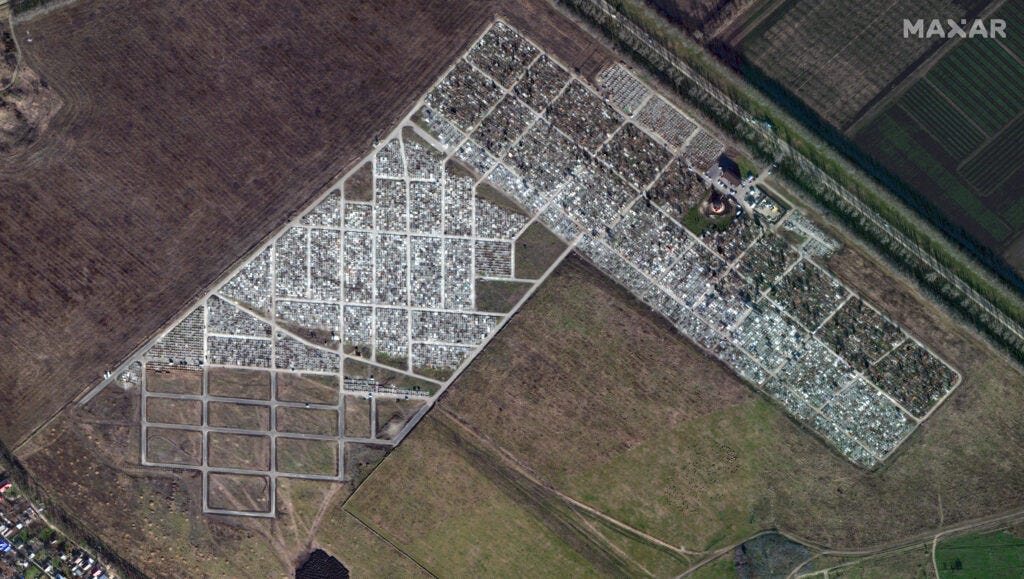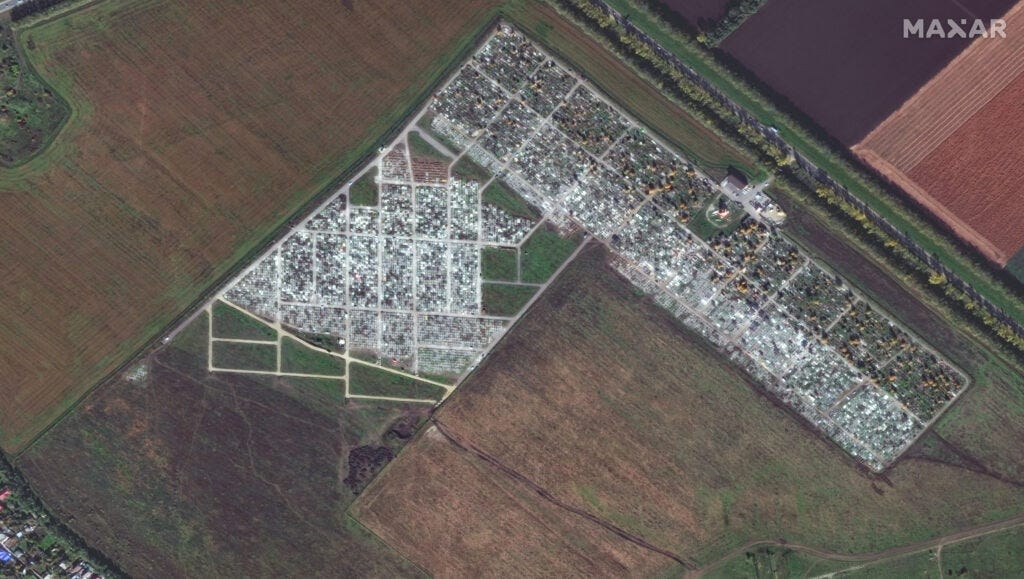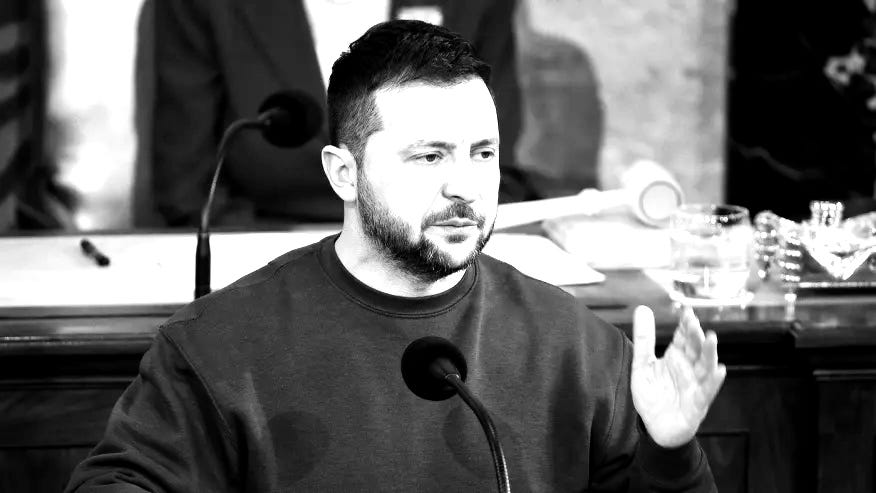Ukraine has lost a third of its population since the start of Russia's invasion: what's next?
in our first ever microscope deep dive, we explore how Ukraine weighs the cost of survival in a war shaped by betrayal and hard truths.
This post is the first in our new weekly microscope series. In this series, we take a deep dive into the topics shaping our world, looking critically past the headlines to uncover the truth. Become a paid subscriber below to support my work breaking through the narratives.🔬
For this inaugural instalment, the microscope is free. I want to give you a taste of the depth, detail, and substance you can expect from this exclusive series before inviting you to support my work with a paid subscription. I hope you enjoy reading.
Since Russia’s full-scale invasion in February 2022, Ukraine has endured a catastrophic population decline. The war has displaced millions, taken countless lives, and left entire regions under Russian control. The demographic impact is staggering when you really get into it, with significant portions of Ukraine’s population lost to death, exile, or annexation. What remains of Ukraine faces not only a devastating war but also the possibility of long-term demographic, economic, and political turmoil.
For the people of Ukraine, it’s a war for survival whichever way they look at it. As the country’s resources dwindle and its allies falter in their support, a cold reality sets in this winter: the trajectory of the war is currently unsustainable. With the United States increasingly divided on its role in the conflict and many European countries turning inward, the question is—what comes next for Ukraine?
the human cost.
Ukraine’s population has plummeted by approximately 10 million since the onset of Russia’s invasion, according to the United Nations. This figure—roughly a quarter of its pre-war population—includes millions of refugees, war casualties, and those displaced within the country. When we add the populations of Crimea, Donetsk, Luhansk, and other territories now firmly in Russia’s grip, the total loss far surpasses a third of Ukraine’s pre-war population.
This is of course, nothing short of disastrous. A loss like this, millions, particularly women and children, leaves a shattered society behind. History tells us time and time again that refugees rarely return en masse after such large-scale displacements; new lives forged abroad often anchor people elsewhere. For Ukraine, this reality means a future not only of rebuilding infrastructure but also of grappling with an irreparable loss of human capital.
The annexation of eastern territories only serves to amplify the crisis. Russian control over Crimea since 2014 was the beginning, but the latest grabs of Donetsk, Luhansk, and other areas further chip away at Ukraine and its population.
Ukraine’s future now hinges not only on military resistance but also on its ability to retain and rebuild its population—a task made ever harder by the realities of this war, which we will be going through now.
military maladies.
The situation on the battlefield is growing increasingly dire for Ukraine. After nearly three years of grinding away, its military is running out of both resources and manpower. The flow of Western aid, once a forceful torrent, is now slowing to a mere trickle as pressure to prioritise internal spending increases in European countries. The Biden administration has been unable to secure congressional approval for further arms packages, and Donald Trump, poised to return to the presidency, has made it abundantly clear that he wants to cut support altogether. Without this critical lifeline, Ukraine’s capacity to sustain the war effort is faltering.

Perhaps a bigger and more immediate issue, though, is the severe shortage of recruits. Ukrainian officials estimate the country needs 500,000 more troops to hold its defensive lines, but mobilisation efforts are slowing. Years of relentless combat have exhausted Ukraine’s reserves of experienced soldiers, leaving untested recruits to fill the gaps. Reports from the front lines describe Ukrainian forces as outnumbered—by as much as six to one in some areas—and overstretched, struggling to hold back Russian advances. Morale, too, is waning, as conscription becomes increasingly aggressive and resistance to it grows among the population.
This desperation has led to frightening scenes of Ukraine’s Territorial Command Points (TCP), the conscription agency, physically dragging men to the front lines. Widely circulated videos show chaotic street scuffles as conscription officers attempt to force men into service—what can honestly only be described as state-sanctioned kidnapping:
Another clip, even more harrowing, captures a mother shielding her son with her body as TCP officers try to spirit him away. It’s a moment that speaks volumes about the human toll of this war and the desperation gripping Ukrainian society:
These incidents are a real reflection of the wider manpower crisis gripping Ukraine. Years of relentless fighting leave the TCP with few options but to take extreme measures to fill the ranks.
Meanwhile, Russia’s military, despite suffering heavy casualties, continues to press forward on all axes. What many people don’t realise about Russia is that it is willing to absorb staggering losses, and that gives it a brutal edge. While reports of ‘meat waves’ of Russian infantry are almost certainly exaggerated, the reality remains: Russia’s vast manpower pool allows it to sustain offensives that Ukraine simply cannot match. And critically, Russia has not yet tapped into its larger cities for recruitment, signalling that it can still go for a very, very long time.
On the technological front, Russia holds a dominant position in the air. Russian strike bombers, like the Su-34, now operate with relative impunity, dropping JDAMSKI bombs deep behind Ukrainian front lines. Cities such as Zaporizhzhia, once considered relatively secure, have become targets. This air superiority is a significant challenge for Ukraine, limiting its ability to mount effective counterattacks and leaving its forces vulnerable to devastating strikes whereas the Ukraine Armed Forces has mostly relied on smaller scale missiles and drones in recent months.
The recent collapse of the Kursk offensive has further strained Ukraine’s position. Many, who don’t follow the war as closely as I do, saw this as a potential turning point; this operation has instead become a costly stalemate, with reports this week indicating Ukraine has lost over half the territory it initially gained. The offensive, launched amid hopes of silencing critics who accused Ukraine of fighting not to lose rather than to win, now stands as a sobering wake-up call to the reality on the ground.
To put it bluntly, without substantial reinforcements or a dramatic shift in Western support, the military outlook is bleak.
a broken nation and a sold-off future.
Even as the country battles for its survival on the front lines, the war’s economic toll may prove just as devastating. Before the invasion, Ukraine was already grappling with significant debt and underdeveloped infrastructure. Now, after nearly three years of relentless conflict, the country’s economy lies in tatters. Entire cities have been reduced to rubble, industries have ground to a halt, and the government has become reliant on foreign aid to function. The prospect of rebuilding feels less like a beacon of hope and more like an insurmountable burden.

Ukraine’s post-war recovery, whenever it begins, will demand an extraordinary effort. Roads, schools, hospitals, and homes will need to be reconstructed from scratch, requiring billions in investment. Yet, with European nations increasingly turning inward and facing their own economic pressures, the likelihood of significant external assistance diminishes. The United States, too, shows signs of fatigue, with the political appetite for long-term support waning. In a cruel twist, the only country that may have a vested interest in rebuilding Ukraine is Russia—an irony that will not be lost on Ukrainians.
The broader economic fallout paints a grim picture. Analysts suggest that Ukraine will likely be forced to privatise vast swathes of its public resources and industries to secure international loans, potentially handing over critical infrastructure to foreign corporations. For a country already weakened by war, such measures could deepen inequality and stoke resentment, especially if ordinary citizens see little benefit from these deals.
Politically, Ukraine faces another betrayal. Western support, while significant in the early stages of the war, has increasingly felt half-hearted. The aid provided has been just enough to keep Ukraine fighting but not enough to decisively shift the balance. This strategy, whether deliberate or not, has trapped Ukraine in a prolonged and bloody stalemate—a betrayal not just of Ukraine but also of the Western taxpayers who have funded this war without clear outcomes.
And what happens when the fighting stops? History suggests that Ukraine will face yet another exodus. With borders reopened, many of those who stayed to defend their country may leave to reunite with families abroad or to seek opportunities elsewhere, wary of the next inevitable conflict. Ukraine risks becoming a shell of its former self—a deeply indebted, depopulated nation struggling to find its footing in a hostile world.
The irony is stark: a war fought in the name of sovereignty and self-determination may leave Ukraine more dependent on external forces than ever before.
Russia’s hollow triumph.
At this point it should be clear to most reading that the trajectory of this war is not looking positive for Ukraine. To put it bluntly Russia has the resources to go as long as it takes whereas Ukraine's time is now ticking. The likely outcome is that Russia will get what it wants from this war.
But its “victory” comes with its own eye-wateringly devastating price tag. Even if Moscow succeeds in holding onto annexed territories and works together with Trump to force a settlement, it will emerge from this conflict significantly weakened—economically, diplomatically, and demographically.
Russia has already lost its lucrative European gas markets, once a cornerstone of its economy, and forfeited $300 billion in foreign-held assets through sanctions. Once the world’s second-largest arms exporter, Russia has tumbled to eighth place in just two years. The war has strained its military-industrial complex, prioritising domestic consumption at the expense of its once-dominant export market. Western brands, including Zara, McDonald’s, and IKEA, have pulled out of Russia, leaving empty stores and further isolating the country from global markets. This exodus of businesses highlights the severity of Russia’s economic decline and the lasting impact of its growing isolation.
Diplomatically, Russia’s standing is in tatters. Its reckless abandonment of Armenia, a member of its own CSTO alliance, and its blatant violations of UN sanctions (including arms deals with North Korea) have eroded any semblance of international credibility. Russia has alienated its allies, reduced itself to dependence on Chinese and Iranian partnerships, and isolated itself further from global systems.
Then there’s the demographic fallout. Russia has suffered staggering military casualties, depleting its population of young men—a crisis that will echo for decades. A nation already grappling with declining birth rates now faces an accelerated demographic decline, compounded by an uptick in professionals and dissidents leaving the country.

Even strategically, the war may backfire. By invading Ukraine, Russia has turned the largest East Slavic nation from a historical ally into a sworn enemy. NATO has indeed expanded its presence near Russian borders, with troops and aircraft now stationed hundreds of kilometres from Moscow. These developments, while not immediate existential threats, significantly undermine Russia’s long-term security.
In the end, Russia’s “great power” ambitions may collapse under the weight of its own hubris. Its territorial gains come at the cost of economic stagnation, international isolation, and internal instability. Moscow may secure the land it wants, but this victory could ultimately prove as hollow as the promises of the war itself.
Ukraine’s rock and hard place.
For Ukraine, the path ahead is going to be tough whatever happens. Fraught with impossible choices, it faces the looming orange spectre of Trump and his idea of a brokered peace deal which will likely force Ukraine into ceding occupied territories to Russia. On the other hand, a commitment to continue fighting risks further devastation, potentially dragging the conflict into an insurgency that could last decades.
The recent admission by President Zelensky that Ukraine will no longer fight militarily for Crimea is a clear shift in tone. It signals an acknowledgment of the country’s increasingly desperate position. The failure of the Kursk offensive and the rapid erosion of Ukraine’s defensive lines have only intensified calls for negotiations. However, any deal that leaves Ukrainian territory in Russian hands would be a bitter pill to swallow—one that many Ukrainians may never accept.
Even if Ukraine does agree to a ceasefire, it probably won’t end the war in the hearts of many of its people. The prospect of an insurgency has already been raised by Ukrainian officials, with some openly stating they would fight "to the last man" if forced. This would transform the conflict into a protracted guerrilla war, and we know how Russia deals with that sort of thing. Such a development would draw brutal reprisals from Russia and create an even more devastating humanitarian crisis.
Yet, the alternative—continuing the war with dwindling resources and limited Western support—is equally grim. Ukraine faces a growing manpower crisis and is increasingly outmatched by Russia’s air superiority and sheer numbers. Western nations appear unwilling to escalate their involvement, and with Donald Trump likely to return to the White House, the prospect of increased U.S. aid is virtually non-existent.
Ukraine’s leaders are caught in an unenviable position: fight on and risk collapse, or negotiate and risk betrayal. Whichever path they choose, the cost will be enormous—not just for Ukraine, but for its people, its sovereignty, and its future as an independent state.
a survival story written in blood and betrayal.
Ukraine’s war with Russia is no longer just a fight for territory; it’s a fight for survival on every front—military, economic, and existential. The staggering loss of population, the collapse of infrastructure, and the dwindling Western support paint a bleak picture of the country’s future. Yet the path forward remains perilous, with no clear resolution in sight.
For Ukraine, the cost of either choice—negotiation or continued conflict—is almost unbearable. A peace deal brokered under pressure from the West would likely leave key territories in Russian hands, a betrayal of Ukraine’s sovereignty and the sacrifices made by its people. On the other hand, continuing to fight risks turning the country into a hollowed-out battlefield, with a dwindling population and shattered economy.
For Russia, any territorial gains will come at an immense price, both economically and diplomatically. It will hold the land but lose the credibility, resources, and partnerships necessary to maintain itself as a global power. Both nations will emerge from this war battered, and neither can truly claim victory.
Ultimately, the greatest betrayal lies in the gap between the West's promises and its actions. The war in Ukraine has laid bare the limits of Western resolve, exposing a strategy of sustaining Ukraine's ‘survival’ while withholding the means for it to make any progress.
As the world watches, the question remains: how much more can Ukraine endure, and at what point does survival itself come at too great a cost?
And on that note, we come to the end of the first instalment of the microscope. Let me know what you think below.
(Thanks for reading as always. Please give this post a ❤️ and restack.)
In-depth work like this takes time, effort, and dedication. Future weekly instalments of the microscope will be available exclusively for paid subscribers. If you found this analysis valuable, you’ll love what’s coming next. For just €5 a month, you can support independent journalism and my mission to bring clarity to a world clouded by disinformation.
Sources:














There was a Western funded Maidan coup in 2014 that overthrew the elected government of Ukraine, which then recruited the Neo-Nazis movement in Ukraine to terrorize the Russian speaking people living in the Donbas while NATO moved closer to Russia's border ignoring Russia's security concerns. Please don't be fooled by western propaganda.
This war has really been a war triggered by and fought on behalf of the American Empire. Had the USA allowed Ukraine to stay militarily neutral (not join NATO) Russia would not gave invaded. Biden goaded Putin, daring Russia to invade. Once a peace deal was reached between Russia and Ukraine, the USA sent UK Prime Minister Boris Johnson to Kyiv to tell Zelensky not to agree. Now, almost three years in the west is thinking of abandoning Ukraine and you can bet Ukraine will be required to give away all of its public services to the profit-gouging corporations whom the American Empire serves. Another American success story. Another notch on Biden’s belt.